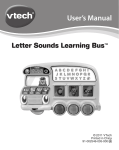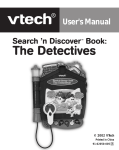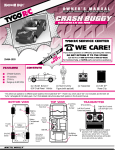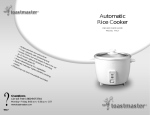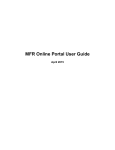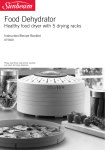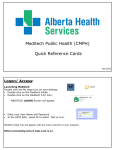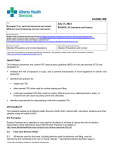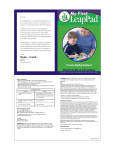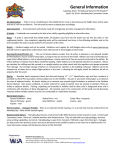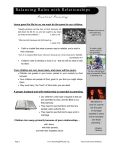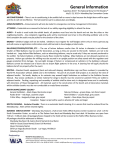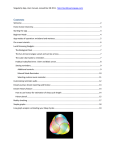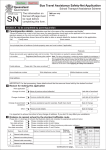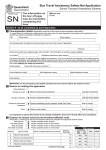Download Volume 27#2 Summer - Alberta Health Services
Transcript
Vol. 27#2 Summer 2015 For all people interested in the health of preschoolers Summer is usually a carefree time. With hot, sunny days, this season offers a great chance to relax and improve our health habits. Healthy eating and active living are great health habits to develop. Choosing to eat more vegetables and fruits seems easier when they are cheaper in price and available in greater variety and abundance. Crisp salads and raw vegetables just seem to taste better in the summer! Hot days and long hours of daylight should make it easier to become more active. Hikes, walks, and trips to the park are great activities that don’t cost a lot of money. If you participate in sports, remember to wear the proper protective gear. When out riding your bicycle, remember to wear your helmet. Although adults over 18 are not required by law to wear a helmet, kids look up to adults and model their behavior. Be a good role model in all that you do. Children notice. If you are planning foreign travel this summer, call Travellers’ Health Services at least 8 weeks before leaving Canada. Many foreign countries have diseases that you do not find in Canada. To protect yourself and your family while travelling, call (780) 735-0100 or call Alberta Health Link, 1-866-408-5465 outside of Edmonton or (780) 408-5465. Have a Happy Summer! Inside this Issue Dear Health Centre: Preschool Settings Manual..... Page 2 Communicating With Toddlers ........................... Page 3 Sleep ............................................................. Page 4 Environmental Health News ............................... Page 5 Healthy Eating on a Budget ............................... Page 6 Dental Accidents ............................................. Page 7 Outdoor Safety ................................................ Page 8 Recipe Page .................................................... Page 9 Resource Page ................................................ Page 10 Contact is a publication of Public Health – Edmonton Zone, Alberta Health Services. Information in this newsletter can be freely reproduced for educational non-profit purposes by any childcare centre in Edmonton area. Contact is edited by Pam Todd. Phone: 780-342-1284 Fax: 780-484-9156 The information provided in this resource is not to be used for consultation during an emergency, to make or confirm a diagnosis or to treat people, as a substitute for obtaining medical advice or for seeking treatment from a qualified doctor. www.albertahealthservices.ca Letters to the Health Centre Dear Health Centre Are any sections in the “Healthy Children in Preschool Settings” manual out of date? Best Daycare Dear Best Daycare, As with most paper manuals, there is some information in this manual that is out of date. The manuals will not be reprinted. Although most of the information in the manual is still fine to use, the following sections should be removed from the manual since they have incorrect information: Section Tab Growth and Development Preventing Injuries Communicable Disease/Infection Control Recommendation Remove entire section Remove car seat information What is out of date? Information about sleep Vitamin D recommendations Car seat recommendations Feeding recommendations Information about when to move children out of cribs is misleading Sunscreen information is misleading Car seat safety information Some information is different from Environmental Health recommendations. Please use Environmental Health information (see link on back page of newsletter). Do not copy these pages for parent handouts. They are provided as a general reference only. Call Health Link for the most up to date information. Immunization schedule Remove entire section Communicable Disease Fact Sheets Use for reference only – not for parent handouts Immunization Remove entire section In the future, an updated version of the manual may be available online. We will let you know when that happens. Refer to the last page of this newsletter for some reliable information sources that we recommend for you to use. Your Public Health Nurse AHS Edmonton Zone Public Health, Childcare Initiative Newsletter. Volume 27 #2 2 Communicating with Toddlers Help For a Child Who Stutters You communicate to your toddler with your words and actions. When you talk to your toddler, get her attention first. Stop what you are doing and call her name. Wait for her to look at you before talking. You can use communication to build relationships. Toddler Property Laws If I like it, it’s mine. If it’s in my hand, it’s mine. If I can take it away from you, it’s mine. If I had it a little while ago, it’s mine. Show pleasure. If it’s mine, it must never appear Share your pleasure with your toddler when she learns new things and acts in ways that are okay. Make sure your voice and face match your emotion. to be yours in any way. If we are building something together, all of the pieces are mine. Use the sound of your voice. If you are concerned, sound concerned. If you want your child to stop throwing her food, say it firmly without yelling. If it looks just like mine, it’s mine. If I think it’s mine, it’s mine. If I give it to you, and change my mind later, it’s mine. Get down to her level. When your child talks to you, squat down so your eyes are level with hers, if possible. Even when you are busy, turn and look at her. Really listen. Listen and respond to what she says, and to the thoughts and feeling she shares with you. If it’s broken, it’s yours! Author Unknown Information provided from: Healthy Parents Healthy Children: The Early Years Keep it simple. Young children need simple rules and limits suited to their age. Keep information short and use words your child understands. AHS Edmonton Zone Public Health, Childcare Initiative Newsletter. Volume 27 #2 3 Sleep Sleeping: Older Toddlers and Bedtime Routines Most toddlers will try to come out of their room when they have been put to bed. Your older toddler can learn that she needs to stay in bed so that she can go to sleep. She may want to get out for all kinds of reasons (e.g., she's more independent, wants more control of her life, anxious about being away from you). She may beg to stay up, refuse to lie down or even have a temper tantrum. Stay calm - especially if she is not. You can promote peaceful bedtimes by providing warmth and structure. Provide warmth. Realize that many children find moving to a bed both exciting and scary. Reassure your child that you are near and will keep her safe. Provide structure. Keep bedtime calm and quiet. Close her door, but don’t lock it. Most fire departments recommend closing all bedroom doors at night to protect your family from fire and smoke. Locking her door can frighten her and can be dangerous. If she comes out of the bedroom after you've put her to bed, take her hand, walk her back to her room, remind her that it's bedtime and tuck her in. Avoid arguing. Simply say “It’s time for bed". You may have to do this many times for several nights before she accepts it. Be kind and firm. By being kind, you let her know you understand she would rather stay awake. By being firm, you let her know that it really is bedtime. Sleep Habits of the 3 and 4 Year Old Preschooler When children get the sleep they need, they are happier and healthier. Young children need about: 12 hours of sleep a night when they’re 3 years old 11 hours of sleep a night by the time they’re 5 years old Many children nap for about an hour a day until they are over 5 years old. Other children quit napping before this age. Your preschooler is probably not getting enough sleep if he: Regularly falls asleep during the day (e.g., in the car, watching television, looking at books). Needs you to wake him up every morning. Seems cranky during the day. Naps more than once a day. Information provided from: Healthy Parents, Healthy Children: The Early Years AHS Edmonton Zone Public Health, Childcare Initiative Newsletter. Volume 27 #2 4 Environmental Health News Bed Bugs There is a worldwide resurgence of bed bugs. They are everywhere. Having bed bugs in your home is not an indicator of poor hygiene or low economic status. However, having bed bugs causes mental anxiety and stress. Childcare providers and parents have many questions and concerns when it comes to bed bugs. Here is some information that can help. Isolate worn clothes in a plastic bag and seal the bag or put clothes immediately into the dryer for 30 minutes. Keep outerwear and bags separate from your other clothing Bed Bugs at the Childcare Centre If you believe that you may have bed bugs in your home, the following may help reduce the risk of spreading bed bugs: Bed bugs come to schools and childcare facilities from infested homes. Bed bugs travel place to place in people’s belongings (clothing, backpacks, blankets, etc.). Bed bugs do not transmit disease. Wash and dry clothes and place immediately into a clean, sealed bag. These are your bed bug free clothes. Ensure any bag or objects you have to take with you are separated from other objects in the home. Children and staff do not need to be excluded if they or their home has issues with bed bugs. If possible, keep purses and bags in a sealed bag when in the home. Bed bugs must be treated immediately to prevent further spread. Prior to leaving the home, change into bed bug free clothes at the entrance door and leave immediately. What to Do if Bed Bugs are Found or Suspected Childcare staff must: Notify the parent/guardian if they notice bed bug bites on a child. Notify the parent/guardian if a bed bug is found in a child’s clothing or belongings. Place the item(s) in a sealed plastic bag. Notify Environmental Public Health if bed bugs are present in the facility. Call a pest control company and continue to implement protective and environmental clean-up measures. Meaghan Allen Environmental Health Officer Alberta health Services Limiting the Spread If you believe that you may have been in a premises that has bed bugs, the following precautions can be taken when arriving home: Change your clothes as close to the entrance as possible. Avoid changing clothes in your bedroom. AHS Edmonton Zone Public Health, Childcare Initiative Newsletter. Volume 27 #2 5 Healthy Eating on a Budget Healthy Eating on a Budget Preschoolers need a variety of healthy foods to get the energy and nutrients they need. Healthy eating does not have to be expensive. Here are some tips to plan a healthy menu at your centre and stay within budget. Plan Ahead. Take time before grocery shopping each week to plan your menu. This will reduce waste and save money. Plan ahead to save time and gas by avoiding extra trips to the grocery store throughout the week. Menu plan – create re-usable weekly or monthly menu plans. Use your menu to plan your grocery list. Knowing exactly what and how much to buy will help reduce the amount of food wasted. Watch for sales and shop in season – plan your menu around sale items and produce that is in season. In season produce is often least expensive and most fresh. Buy bulk – buying bulk often costs less. Buy foods you use often in large quantities such as rice, pasta, dried fruit, oatmeal, and beans in bulk to save money. Budget Friendly Protein – some cuts of meat can be expensive. Plan your meals using less costly cuts of meat and plant sources of protein. Prepare meatless dishes often – beans, legumes, and tofu are healthy, are good sources of protein, and cost less than meat. Add these items to soups, stirfries, or salads for a healthy, protein packed meal. Buy less expensive cuts of meat – use less tender cuts of meat, such as flank or round. Marinate them or use them in stews and sauces. Whole chickens or chicken pieces that still have the skin and bones are less expensive than skinless, boneless pieces. Taking a little extra time to remove the skin and bones can save money. Avoid prepackaged foods – Make your own baked goods and snacks. It costs less and is healthier than buying prepackaged foods. For example, instead of buying premade granola bars, make your own with oats, dried fruit*, and unsweetened coconut. Buy frozen or canned vegetables and fruit – they are just as healthy as fresh ones and often cost less. Buy “no salt added” or “low sodium” canned vegetables and canned fruit packed in its own juice. Look for plain frozen vegetables and fruits without added sugar or salt. *Caution: Dried fruit can be a choking hazard for younger children. Please consider the child’s age and their eating skills before offering. For more information on healthy eating in childcare, go to: Healthy Eating Starts Here at www.healthyeatingstartshere.ca Click on Healthy Eating at Child Care Centres. Stay Tuned! …AHS Dietitians are planning a nutrition workshop series for childcare providers. Topics will include menu planning, allergies and more on healthy eating for preschoolers. Listen for workshop details at upcoming childcare sector meetings, from your licensing agency and/or public health nurse. At the Grocery Store – follow these tips and tricks at the grocery store to stretch your food dollars. Shop on discount days – contact your local grocery store to find out if they have a monthly discount day. Many stores offer 10 – 15% off your grocery bill for shopping on certain days of the month. AHS Edmonton Zone Public Health, Childcare Initiative Newsletter. Volume 27 #2 6 Dental Accidents Summer is here! Children will be spending more time outdoors at the park, riding bikes, playing road hockey, and just enjoying the fresh air and sunshine. Exercise is important for a child’s health and well-being, but accidents can happen. Having a tooth knocked out is one example of a dental accident. Knowing what to do when that happens can make the difference between saving and losing a tooth. Take the following steps if the knocked-out tooth is an adult/permanent tooth. Quick action is critical. Immediately find the knocked out tooth. Handle the tooth carefully. Pick it up touching only the crown (the chewing surface of the tooth) and not the root. If the tooth is dirty, rinse the tooth gently in cool water. DO NOT clean the tooth with soap or chemicals. Do not scrub the tooth, dry the tooth, or wrap it in a tissue or cloth. Replace the tooth in the socket immediately, if possible. The socket is the empty hole in the mouth where the tooth used to be. To replace the tooth, carefully push the tooth into the socket with your fingers, making sure the tooth is facing the right way around. To keep the tooth in place, have the child gently bite down on a clean gauze or washcloth. Keep the tooth wet at all times. Do not allow the tooth to dry. If the tooth cannot be put back into the socket right away, put the tooth in a clean container of cold milk. If milk is not available, put the tooth in a container with the child’s saliva. DO NOT store the tooth in regular tap water. If the child is calm and there is no danger of swallowing the tooth, you can place the tooth in the child’s cheek to keep it wet. Take the child (and the tooth) to the nearest available dentist as soon as possible. If the tooth is replaced within 30 minutes, there is a good chance that the tooth will take root again. Baby teeth have an important job. They save room or a place in the child’s mouth for the permanent teeth. If a baby tooth is knocked out, here are some things to remember. Call the child’s dentist as soon as possible. Quick action can lessen a child’s discomfort and prevent infection. If the child’s mouth is bleeding, rinse with cold water, place gauze or clean washcloth where the tooth is missing and have the child bite down on it. The pressure will usually stop the bleeding. Spend time comforting the child rather than looking for the tooth. Do not put a baby tooth back into the socket because of risk of damaging the adult tooth developing in the tissue underneath the socket. Kim Havel Registered Dental Hygienist Alberta Health Services AHS Edmonton Zone Public Health, Childcare Initiative Newsletter. Volume 27 #2 7 Summer Safety Outdoor Safety Pedestrian Safety Active living is an important part of healthy child development. You can help your child stay safe when he rides his bike, walks and plays outdoors. Be sure he wears protective gear and gets the right training for any sports or activities. Helmets By law, anyone under 18 years old in Alberta must wear a helmet when riding a bicycle, tricycle or when in a bike trailer. Helmets are strongly recommended for adults too. Children learn by example. Use helmets that are designed for the activity hockey helmets for hockey and bike helmets for cycling. Always take your child’s helmet off before he plays on playground equipment. For more information about using the correct helmet, visit www.myhealthalberta.ca and enter the key works “bike helmet” in the search box. Walking is great exercise. Preschoolers still need to walk with an adult. Children under 9 years old do not have all the skills, awareness or judgment to determine when it is safe to cross the street. Start teaching your preschooler the skills he needs, but make sure you (or another adult) are with him whenever he crosses a street. Preschoolers are still impulsive. Insist that he hold your hand when he is near traffic or in a parking lot. For more information about pedestrian safety, visit www.albertahealthservices.ca/4920.asp. Information provided from: Healthy Parents, Healthy Children: The Early Years Bicycle Safety Some preschoolers are able to ride a bike, but they are not ready to ride on the road. It takes skill, practice and time for children to be able to balance the bike, pay attention to where they are going and to watch for cars and road signs. These skills do not develop until you child is between 10 and 14 years old. Ride with your child to teach him the safety rules he will need to know. o Watch for pedestrians. o Stop at all stop signs, even when on the sidewalk Give your child lots of chances to learn basic skills before going on the road with him. For more information about bike safety, visit www.albertahealthservices.ca/4920.asp. AHS Edmonton Zone Public Health, Childcare Initiative Newsletter. Volume 27 #2 8 Recipe Page CABBAGE-APPLE SALAD Food Group: Vegetables and Fruit No. Of Servings/Portion Size: 100/50 mL (1/4 c) Weight Ingredients: Apple, diced or grated Orange juice, 100% pure Cabbage, shredded Mayonnaise, low fat Yogurt, plain, 2% Volume Imperial Metric Imperial Metric 5 lb 8 oz 2.5 kg 4 lb 8 oz 1 lb 9 oz 1.8 kg 250 g 750 g 16 c 1/2 c 16 c 1c 3c 4L 125 mL 4L 250 mL 750 mL Method: 1. Combine apples and orange juice together. Drain. 2. Mix cabbage and apple together. 3. Mix mayonnaise and yogurt together. 4. Add mayonnaise mixture to cabbage mixture just before serving so cabbage does not lose its crispness. Recipe Modification for Infants: Offer apple instead of salad. Adapted from: Day Care Nutrition and Food Service Manual, Nutrition Division, Calgary Health Services, 1992. (Healthy Children in Preschool Settings Manual) BEEF SATAY No. Of Servings/Portion Size: Ingredients: Lean boneless beef (round) Garlic, fresh cloves, crushed Soy Sauce, low sodium Lemon juice Ginger, ground Cumin, ground Coriander, ground Food Group: Meat and Alternatives 100/45 g (1 1/2 oz) Imperial Metric 12 1/2 lb 1.2 T 3/4 c 1/4 c 3T 3T 3T 6.25 kg 8 mL 175 mL 50 mL 45 mL 45 mL 45 mL Method: 1. Cut meat into 1/4-inch (3/4 cm) cubes. 2. In a bowl, stir together garlic, soy sauce, lemon juice, ginger, cumin, and coriander. 3. Add meat and stir to coat evenly. 4. Cover and refrigerate for 2 hours. 5. Place marinated meat on a rack in a broiler pan. Place pan 4-6 inches below heat. 6. Broil 8-10 minutes turning often. Adapted from: Day Care Nutrition and Food Service Manual, Nutrition Division, Calgary Health Services, 1992 (Healthy Children in Preschool Settings Manual) For more recipe ideas, visit the AHS Child Care “Healthy Eating Starts Here” website: http://www.albertahealthservices.ca/8941.asp AHS Edmonton Zone Public Health, Childcare Initiative Newsletter. Volume 27 #2 9 Resource Page Focus on…My Health Alberta MyHealth.Alberta.ca has information on more than 8,700 health topics! The types of content you can find include: Health A-Z: find common health topics, a symptom checker and other health tools. Healthy living: find information about topics such as healthy kids, fitness and exercise, healthy eating and weight, dealing with stress, and mental health. Tests and treatments guides: find out why and how a test is done, how to prepare for it, how it feels, possible risks, results, what affects the test, and what to think about. Medication guides: find out how medications work, why they are used, side effects, and things to keep in mind while using the medication. Health services: helps you find health professionals, services, program details and locations. Health alerts: warnings about health issues in Alberta, restaurant inspections, and travel health advisories (information on disease outbreaks around the world). Decision tools: can help you decide about a treatment option and how you want to care for your body. These tools use both facts and feelings to help make decisions about your health. Health checkup tools: can help you figure out how you’re doing (such as if you’re a healthy weight) and make changes in your lifestyle that can improve your health. My Health Alberta is a partnership between Alberta Health and Alberta Health Services. It is reviewed regularly to make sure it is up to date. Important Contacts for Child Care Providers Do you want information about community services? Call 211 Government of Alberta Child Care Orientation Course http://childcare.basecorp.com/home Call HealthLink 24 hours a day with questions about health or health services. Edmonton (780408-5465) or Toll-free (1-866-408-5465) AHS Environmental Health has some excellent resources for Child Care Agencies: To looks up health information on-line: MyHealth.Alberta.ca Government of Alberta Family Day Home Standards Manual for Alberta http://www.humanservices.alberta.ca/document s/family-day-home-standards-manual.pdf Health and Safety Guidelines for Child Care Facilities http://www.albertahealthservices.ca/EnvironmentalHealth/wf-ehhealth-safety-guidlines-child-care-facilities.pdf Home Study Course in Child Care http://www.albertahealthservices.ca/EnvironmentalHealth/wf-ehhome-study-child-care.pdf Do you have questions or concerns about an outbreak? Call the outbreak pager (780-445-7226) For ideas on creating a healthy eating environment, visit the AHS Child Care “Healthy Eating Starts Here” website: http://www.albertahealthservices.ca/8941.asp AHS Edmonton Zone Public Health, Childcare Initiative Newsletter. Volume 27 #2 10










